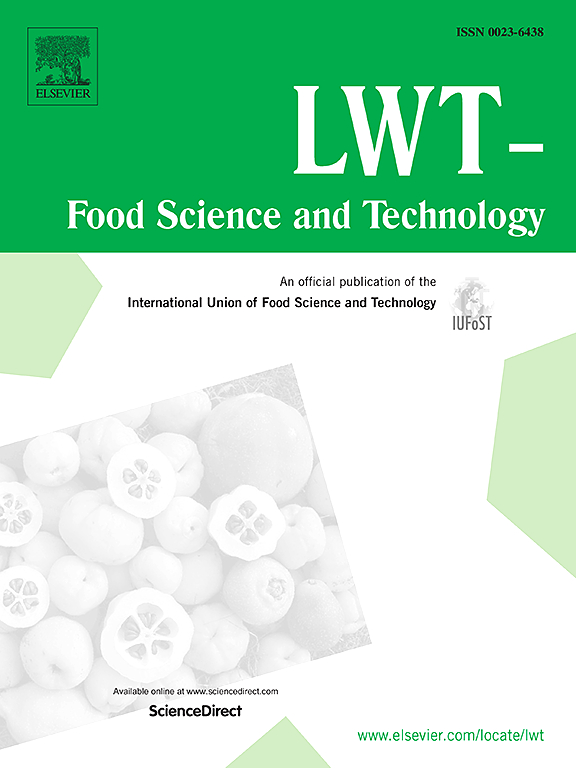PacBio 测序结合 GC-IMS 方法研究用太湖黑猪制作的金华火腿的风味形成
IF 6
1区 农林科学
Q1 FOOD SCIENCE & TECHNOLOGY
引用次数: 0
摘要
在本研究中,我们评估了用太湖黑猪制作的金华火腿在 210 天成熟期的理化和微生物特性、微生物多样性和挥发性有机化合物(VOCs)。在八个时间点中,金华火腿的蛋白质氧化值、蛋白质分解指数和 TBARS 值均有不同的变化趋势。细菌总数和葡萄球菌总数的增长呈下降趋势,而真菌总数的增长呈抛物线趋势。马葡萄球菌是优势菌种,相对丰度为 19.3%(第 180 天)-76.7%(第 120 天)。德巴里酵母菌(Debaryomyces hansenii)和欧洲酵母菌(Eurotium sp.GC-IMS 分析检测到 84 种挥发性化合物,其中醇类和醛类是晚熟期的主要挥发性化合物。微生物多样性与挥发性有机化合物之间的相关性分析表明,等位葡萄球菌与 8 种挥发性有机化合物呈显著负相关,而德巴酵母菌(Debaryomyces hansenii)和欧洲酵母菌(Eurotium sp.)分别与 31 和 29 种挥发性有机化合物呈显著相关。我们的研究结果揭示了用太湖黑猪制作的金华火腿的质量、微生物物种多样性、挥发性化合物特征以及微生物群落与风味形成之间的关系。本文章由计算机程序翻译,如有差异,请以英文原文为准。
PacBio sequencing combined GC–IMS approach to investigate the flavor formation of Jinhua ham prepared using Taihu black pigs
In the present study, we evaluated the physicochemical and microbial properties, microbial diversity, and volatile organic compounds (VOCs) of Jinhua ham prepared using Taihu black pigs during a ripening period of 210 days. During the eight timepoints, the protein oxidation, proteolysis indexes, and TBARS values of Jinhua ham had different change trends. The growth of total bacteria and total Staphylococcus showed a decline, while the growth trend of total fungi was parabolic. Staphylococcus equorum was the dominant bacterial species, and the relative abundance were 19.3% (day 180)-76.7% (day 120). Debaryomyces hansenii and Eurotium sp. were the dominant fungus species, with opposite change trends. GC–IMS analysis detected 84 volatile compounds, with alcohols and aldehydes being the dominant volatile compounds in the late ripening period. The correlation analysis between microbial diversity and VOCs showed that Staphylococcus equorum was significantly negatively correlated with eight VOCs, while Debaryomyces hansenii and Eurotium sp. were significantly correlated with 31 and 29 VOCs respectively. Our findings reveal the quality, microbial diversity at species level, volatile compound characteristics, and relationship between microbial communities and flavor formation of Jinhua ham prepared using Taihu black pigs.
求助全文
通过发布文献求助,成功后即可免费获取论文全文。
去求助
来源期刊

LWT - Food Science and Technology
工程技术-食品科技
CiteScore
11.80
自引率
6.70%
发文量
1724
审稿时长
65 days
期刊介绍:
LWT - Food Science and Technology is an international journal that publishes innovative papers in the fields of food chemistry, biochemistry, microbiology, technology and nutrition. The work described should be innovative either in the approach or in the methods used. The significance of the results either for the science community or for the food industry must also be specified. Contributions written in English are welcomed in the form of review articles, short reviews, research papers, and research notes. Papers featuring animal trials and cell cultures are outside the scope of the journal and will not be considered for publication.
 求助内容:
求助内容: 应助结果提醒方式:
应助结果提醒方式:


